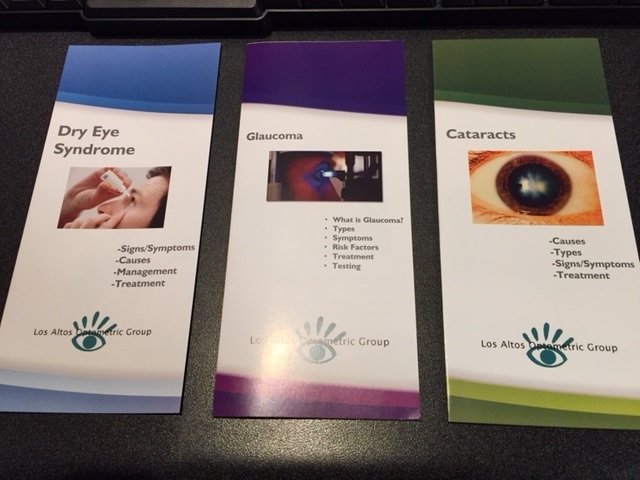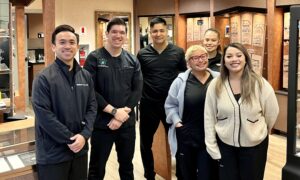By Aaron Neufeld, OD

Nov. 1, 2017
Medical eyecare is a needed service that can help build revenues, offsetting the competition for product sales from online retailers. But you have to get the word out about what you do. Marketing that you do more than glasses and contact lenses is essential.
Medical eyecare represents around 10 percent of my three-OD, one-location practice, with the following areas playing the greatest drivers of those revenues: Dry eye syndrome treatment including punctal plugs, glaucoma management including all relevant testing such as fundus photos and OCT, anterior segment disease management including topography/OCT and visual fields for a variety of conditions.
We forecast that medical eyecare will grow to 15 percent, and perhaps even 20 percent, of our practice in the next 5-10 years.
Internal & External Marketing for as Little as $500 Annually
Medical eyecare marketing is done internally and externally at our office.
Internal efforts include brochures and slide shows detailing our services in the reception area, as well as word-of-mouth education from doctors and staff. The brochures educate patients on conditions such as glaucoma, dry eye, macular degeneration and cataracts, along with information about the related services my practice offers. We create some of these brochures ourselves, and some are provided for free from our vendors.
In our reception area, we have an electronic “picture frame,” or small screen on a table, with a slide show on the advanced technology available in our office, such as our OCT, and how those instruments can be used to screen for, and monitor, eye disease.
External medical eyecare marketing includes Facebook/Instagram boosts, Google Adwords, and brochures sent by postal mail. When we recall patients, the postcards we send via postal mail includes information about our retinal imaging technology, and how coming in for an appointment will do more than supply them with another year of contact lenses and a new pair of glasses–it will screen their eyes to ensure that there is no underlying sight-threatening condition.
I try to personally design all our ads, as I’ve found I have a surprising aptitude for it, and it doesn’t take me more than a few hours of after-hours time per month. Occasionally, we use generic-looking advertisements created from stock photos found online, paid for by our practice for use, if not available for free. Usually it takes me about an hour to design an ad or refresh a brochure.
Total costs per year: $500.
Market Online: Social Media & Doctor Directories
We are conscious that prospective patients will search for us, and happen to see us, in the news scrolls on their friends’ Facebook pages. So we make an effort to frequently post material related to medical eyecare services:
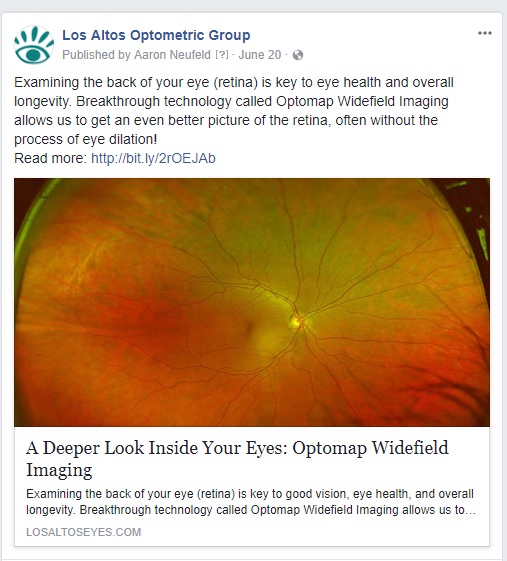
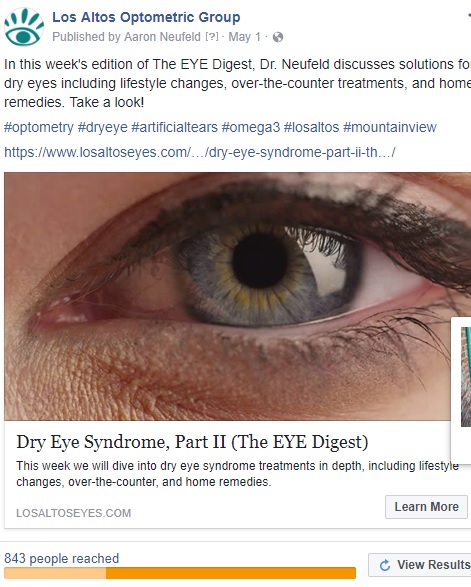
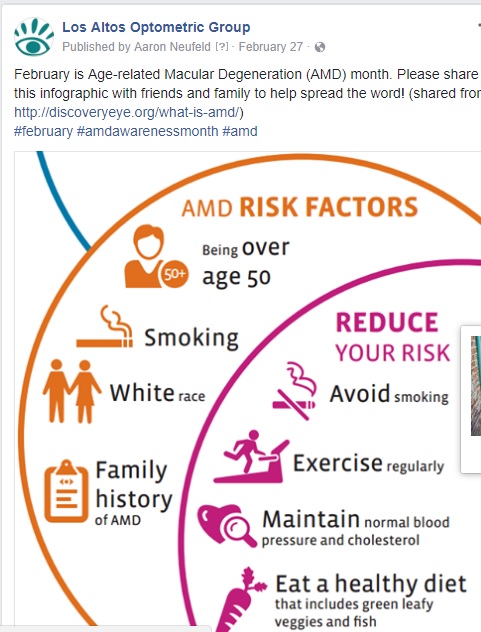
I have a practice blog, The EYE Digest, which I update at least monthly, posting a link to a new post on our practice Facebook page each time it is published.
In addition to our posts on social media, and the information available on our practice web site, some vendors we work with will place us on their online provider directories at no additional cost. An example of this would be the Orion Vision Group (specialty contact lens supplier). Being on provider directories, such as Orion’s, have helped us gain additional patients, who go online to search for a doctor for specialized services.
Talk to Patients About Your Medical Eyecare
The experience your patients have in your office–what they see and hear–informs how they perceive your services. In our office, the reception area and optical are comfortable and spacious, and allow for easy viewing of our products, but our medical eyecare also is apparent. In addition to the educational brochures and slide show, there often is signage on the wall about ocular health, and the importance of annual comprehensive exams.
More importantly, I discuss medical eyecare with each of my patients, and so does my staff. When booking appointments, or talking about their current appointment, we don’t just note the opportunity to get a contact lens prescription renewal and glasses, but the screening for eye disease that the patient will receive.
Two important points we like to emphasize about medical eyecare:
We provide all medical eyecare services to the fullest extent of our scope (so basically everything but surgery)
The medical portion of the eye exam not only checks for eye disease, but systemic disease, such as diabetes, often detecting symptoms of it before those symptoms are noted by a primary care doctor.
We Speak to Your Community About Medical Eyecare
My partners and I speak at events that are best for reaching our target demographic. This includes talks at senior centers and convalescent homes. We also try to educate individuals at Chamber of Commerce mixers about the vastness of our medical scope.
For instance, at a senior center we might talk about cataracts, and field questions about the procedure, including what to expect, and the opportunity for youthful vision with advanced IOL technology. We also are careful to note the role of optometrists in co-managing cataract surgeries. Many don’t realize that an optometrist often co-manages not just cataracts, but other eye diseases, and in some cases, may be able to be the only doctor the patient visits for those conditions.
At Chamber of Commerce events, we let other members, including MDs with local practices, know of our services, and that we are available to send patients to. We point out the advanced technology we have available to take care of their patients.
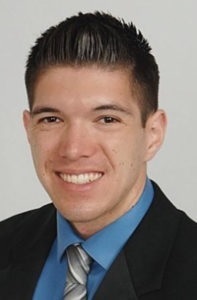 Aaron Neufeld, OD, is the owner of Los Altos Optometric Group in Los Altos, Calif. To contact: aneufeldod@gmail.com
Aaron Neufeld, OD, is the owner of Los Altos Optometric Group in Los Altos, Calif. To contact: aneufeldod@gmail.com

